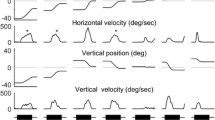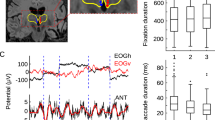Summary
The cortical mechanism of eye-movement control was investigated by recording single cell activity from the frontal eye field (FEF) in unanesthetized monkeys seated in a primate chair with head restrained. Two types of cells (I and II) were found. Type I neurons fired during voluntary saccades occurring in a given direction and during the fast phase of nystagmus. Cells of this type were silent during slow pursuit movement. Type II cells showed steady discharge when the eyes were oriented in a specific direction. These cells discharged also during smooth pursuit movements and the slow phase of nystagmus, provided that the eyes were moving across positions which would have been associated with neuronal activity had the eyes come to rest there. All of Type II and a few of Type I neurons were identified by antidromic response to stimulation of the cerebral peduncle. These results indicate that cortical neurons have patterns of discharge distinctly related either to saccadic or to pursuit movements, in line with the view that these two different types of eye movement are generated by distinct neuronal mechanisms.
Similar content being viewed by others
References
Bizzi, E.: Discharge of Frontal Eye Field neurons during eye movements in unanesthetized monkeys. Science 157, 1588–1590 (1967).
Bossom, J.: Unpublished results.
Brindley, G.S., and P.A. Merton: The absence of position sence in the human eye. J. Physiol. (Lond.) 153, 127–130 (1960).
Cooper, S., P.M. Daniel and D. Whitteridge: Muscle spindles and other sensory endings in the extrinsic eye muscles; the physiology and anatomy of these receptors and their connections with the brainstem. Brain 78, 564–583 (1955).
Crosby, E.C., R.E. Yoss and J.W. Henderson: The mammalian midbrain and isthmus regions. Part II, the fiber connections. D. the pattern for eye movements on the frontal eye field and the discharge of specific portions of this field to and through midbrain levels. J. comp. Neurol. 97, 357–383 (1952).
Dodge, R.: Five types of eye movements in the horizontal meridian plane of the field of regard. Amer. J. Physiol. 8, 307–329 (1903).
Davson, H.: The Eye. Vol. 3, pp. 63–143. New York: Academic Press 1962.
Evarts, E.V.: Pyramidal tract activity associated with a conditioned hand movement in the monkey. J. Neurophysiol. 29, 1011–1027 (1966a).
Evarts, E.V.: Methods for recording activity of individual neurons in moving animals. In: Methods in medical research, pp. 241–250. Ed. by R.F. Rushmer. Chicago/Ill.: Year Book Medical Publisher 1966b.
Evarts, E.V.: Relation of pyramidal tract activity to force exerted during voluntary movement. J. Neurophysiol. (1968a) (in press).
Evarts, E.V.: A technique for recording activity of subcortical neurons in moving animals. Electroenceph. clin. Neurophysiol. 24, 83–86 (1968b).
Ferrier, D.: Experiments on the brain of monkeys. Proc. roy. Soc. B 23, 409–430 (1875).
Fender, D.H.: The eye-movement control system: evolution of a model. In: Neural theory and modeling, pp. 306–324. R.F. Reiss. s Stanford: Stanford University Press 1964.
Fuchs, A.F.: Saccadic and smooth pursuit eye movements in the monkey. J. Physiol. (Lond.) 191, 609–631 (1967).
Grüttner, R.: Experimentelle Untersuchungen über den optokinetischen Nystagmus. Z. Sinnesphysiol. 68, 1–48 (1939).
Hess, A., and G. Pilar: Slow fibers in the extraocular muscles of the cat. J. Physiol. (Lond.) 169, 780–789 (1963).
Horridge, G.A.: Position of onset of fast phase in optokinetic nystagmus. Nature (Lond.) 216, 1004–1005 (1967).
Kuypers, H.G.J.M., and D.G. Lawrence: Cortical projections to the red nucleus and the brainstem in the Rhesus monkey. Brain Res. 4, 151–188 (1967).
Pasik, P., and T. Pasik: Oculomotor functions in monkeys with lesions of the cerebrum and the superior colliculi. In: The Oculomotor System, pp. 40–80. Ed. by M.B. Bender. New York: Hoeber 1964.
Rashbass, C.: The relationship between saccadic and smooth tracking eye movements. J. Physiol. (Lond.) 159, 326–338 (1961).
Robinson, D.A.: The mechanism of human saccadic eye movement. J. Physiol. (Lond.) 174, 245–264 (1964).
Robinson, D.A.: The mechanism of human smooth pursuit eye movement. J. Physiol. (Lond.) 180, 569–591 (1965).
Skakhnovich, A.R., and R.B. Nebieridze: Mechanism controlling the oculomotor apparatus of the rabbit. Fiziol. Zh. (Mosk.) 53, 393 (1967). In: Neuroscience Translations, pp. 33–39. Ed. by R.W. Doty. Bethesda: Md. Fed. Americ. Soc. for Experimental Biol. 1967–1968.
Starr, A.: A disorder of rapid eye movements in Huntington's chorea. Brain 90, 545–564 (1967).
Teuber, H.-L.: The frontal lobes and their function: further observations on rodents, carnivores, subhuman primates, and man. Int. J. Neurol. (Montevideo) 5, 282–300 (1966).
Teuber, H.-L.: The riddle of Frontal lobe function in man. In: The frontal granular cortex and behavior, pp. 410–441. Ed. by J.M. Warren and K. Akert. New York: McGraw-Hill 1964.
Teuber, H.-L., and M. Mishkin: Judgement of visual and postural vertical after brain injury. J. Psychol. 38, 161–175 (1954).
Wagman, I.H.: Eye movements induced by electric stimulation of cerebrum in monkeys and their relationship to bodily movements. In: The oculomotor system, pp. 18–39. Ed. by M.B. Bender. New York: Hoeber 1964.
Westheimer, G.: Eye movement responses to a horizontally moving visual stimulus. Arch. Ophthal. (N. Y.) 52, 932–941 (1954a).
Westheimer, G.: Mechanism of saccadic eye movements. Arch. Ophthal. (N. Y.) 52, 710–724 (1954b).
Young, L., and L. Stark: Variable feedback experiments testing a sampled data model for eye tracking movements. Institute of Electrical Electronics Engineers, Transactions on Human Factors in Electronics. HFE-4. pp. 38–51 (1963).
Author information
Authors and Affiliations
Rights and permissions
About this article
Cite this article
Bizzi, E. Discharge of frontal eye field neurons during saccadic and following eye movements in unanesthetized monkeys. Exp Brain Res 6, 69–80 (1968). https://doi.org/10.1007/BF00235447
Received:
Issue Date:
DOI: https://doi.org/10.1007/BF00235447




